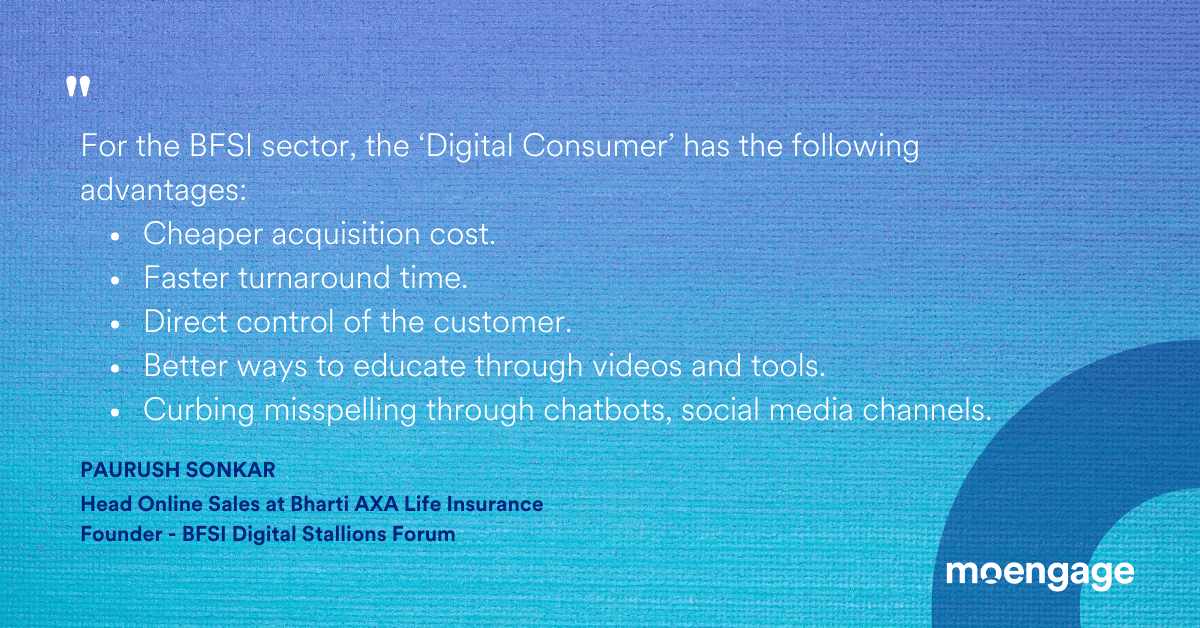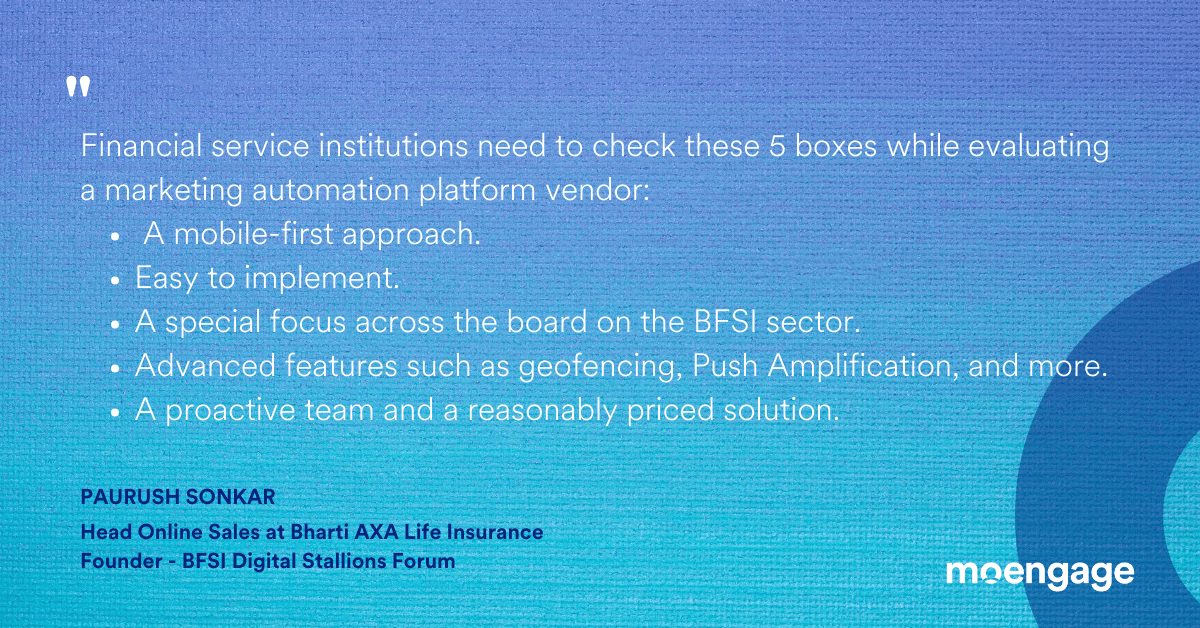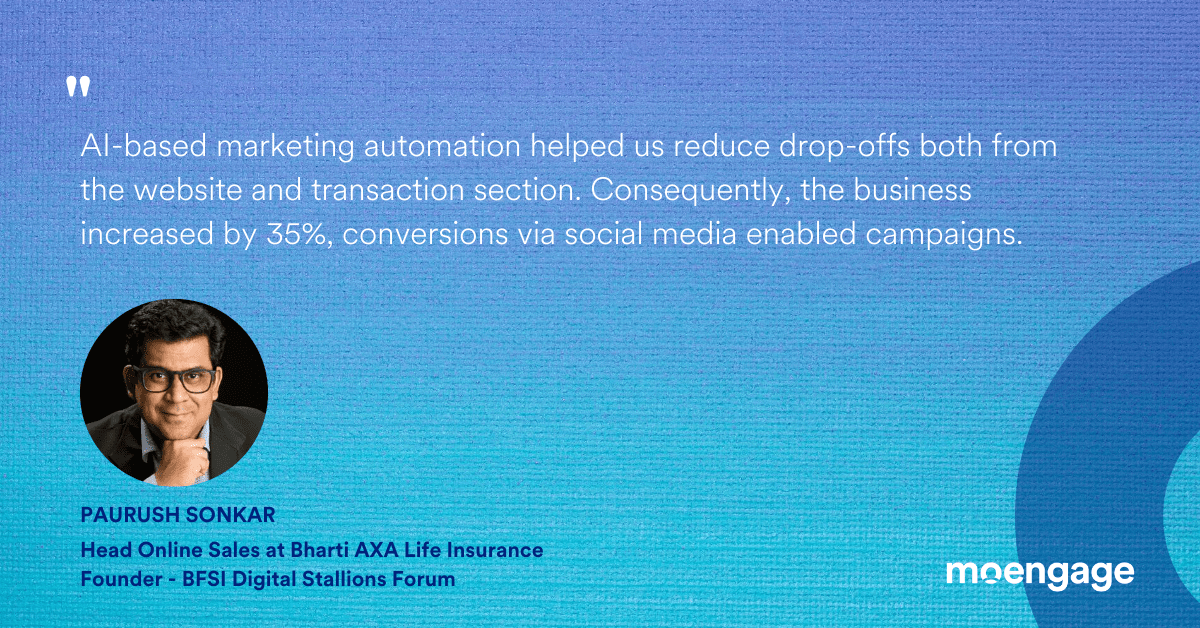How Marketing Automation Enhances Customer Experience in BFSI [Marketer Spotlight]
![How Marketing Automation Enhances Customer Experience in BFSI [Marketer Spotlight]](https://www.moengage.com/wp-content/uploads/2020/08/Paurush-4.png)
Reading Time: 7 minutes
Editor’s note: The trend in 2020 leans toward financial apps that offer great convenience for consumers and business opportunities for the BFSI organizations themselves. A study by Business Insider Intelligence’s Mobile Banking Competitive Edge study suggests that 89 percent of consumers – and a whopping 97 percent of millennials – use mobile banking. The bigger problem, however, is that traditional BFSI companies often lack the technical and pragmatic expertise to engage these “digital-only” and “mobile-only” users. They try to adapt their web and brick-and-mortar customer service best practices for the mobile crowd, only to find that their efforts fall short. Mobile banking can be a particularly vexing environment for financial institutions as they try to acquire, upsell, retain, and engage consumers throughout the entire customer lifecycle. We caught up with Paurush Sonkar, Head Online Sales at Bharti AXA Life Insurance and Founder of BFSI Digital Stallions Forum to understand how technologies such as marketing automation and AI can help the BFSI sector fast-track their digital consumer engagement.
Please share a brief introduction of your background and a few interesting insights from any of the projects you have led.
Paurush: I completed my MBA in the 2002-2004 Batch and started my career with ICICI Lombard General Insurance as a management trainee. I was part of a team called the e-Channel. I started my career on the digital side when digital was all about microsites and e-mailers. As the medium gained prominence, I grew with the medium both from an experience and a knowledge perspective. I have a holistic perspective of digital and financial services, having worked in General Insurance, Life Insurance, Broking, Mutual Funds, NBFC, and more.
The most exciting project that I can recollect was in 2011-2012 at Aditya Birla Capital (Erstwhile Aditya Birla Financial Services Group). I worked alongside the central marketing team to revamp all the digital assets across multiple lines of business, 7 to be precise. The project encompasses website UI / UX, website design, SEO, essential social media presence, content, analytics, and more. It gave me a 360-degree perspective and put me at the helm of the project. I yet remember it was called ‘Project Ultimate.’
Another interesting project was when we launched the online term business and social media at Future Generali Life Insurance. We were a late entrant into social media, so we worked hard to get it right. Within the first year itself, our Twitter campaign won an international award.
We are currently in the midst of a revolution in terms of marketing practices. This is also because consumer behavior has transformed drastically over the last few years. Consumers today are more digitally active. They do not necessarily need a salesperson to lead them to the point of sale, so the role of marketing has shifted from supporting the sales function to engaging with the consumer across the purchase journey.
How have the changing dynamics in the marketing ecosystem impacted the banking and financial services sector?
A lot has changed in the last decade; however, the pace was further accelerated in the recent 4-5 years with internet access nearly free/super affordable. I see a host of things working in tandem to give rise to what we could call the ‘Digital Consumer.’ People began to use wallets to make payments, bill payments moved online, and so did movie tickets and food ordering. If you step back and reflect, all this has not happened overnight, but it has occurred due to sustained efforts by all the stakeholders, and members of the digital ecosystem.

For the BFSI sector, the birth and rise of the ‘Digital Consumer’ has been a boon and has the following advantages:
- Cheaper acquisition cost
- Faster turnaround time
- Direct control of the customer (no intermediary involved)
- More comfortable to educate a customer by way of videos and tools
- Curbing misspelling, which was a rampant practice and seamless servicing options by way of chatbots, social media channels, etc.
The sector has also seen the birth of pure-play online financial players who neither own a brick-mortar branch nor do they sell through any other offline medium. A whole new sector within the banking and financial services called Aggregators/Comparison portals have taken center-stage in this economy which I term as ‘The Economy of Affordable Multiple Choices.’
From your experience, can insurance and financial services rely on an automation tool to connect with their customers? What are some benefits or improvements you’ve seen when these organizations use a marketing automation platform?
Well, my answer is an emphatic YES. Taking it a step ahead, I’ve seen that AI Tools are far superior to even a personal touch interaction between a sales executive and the end customer. BFSI brands are aware that an AI Tool is in a way their 24X7 Branch, their dependable salesman, and the best part is neither does this salesman take a holiday nor does he take tea & smoke breaks, and yes he works over the weekends too.
Let me give you an example of a brand where I headed digital marketing and online sales, and we implemented an AI-based marketing automation tool end-to-end. We saw the following benefits:
- We engaged users better due to personalized content.
- We reduced the drop-offs both from site and transaction section – business increased by 35%, conversions via social media enabled campaign was the biggest beneficiary, and the list is long.
In summary, the AI-based Marketing Automation tool paid for itself in a few months and then became a revenue stream in itself.
At what stage/point in the business does a BFSI company need a marketing automation platform? Are there any ways to evaluate this need for the organization?
I think digital encompasses every touchpoint and process in a business/brand these days. Thus the direct answer is that an AI-based marketing automation tool should have been made ‘yesterday.’ However I am glad to see that most brands are now moving in the right direction, a new age insurance provider signed up for a tool on these lines even before they launched operations, and that is, in my opinion, a bold and the right decision. The company engaged, sold, and serviced their first customers through the tool, and is going strong. The most significant advantage is they are now connected to the customer, and vice-versa like none of their competitors are.
Banking and financial service brands can evaluate the need very quickly by asking themselves the below stated five questions:
- Do I want to bring down my acquisition cost?
- Do I want to target a customer who is the ideal fit (target audience) for my product or is the audience spread too thin?
- Do I want to know each customer individually rather than classify them as 1 of the ten broad profiles that my digital consultant told me about?
- Do I want to cross communicate across channels with the same customer?
- Is my customer a digital-first customer?
At this stage, I would also like to congratulate MoEngage on their special program to support startups by giving them complimentary access to their tools and marketing credits. It is such initiatives that make up the ecosystem worthy and a constantly evolving space.
Thank you, Paurush, for your kind words about MoEngage.
My next question to you is, how can a BFSI company make that purchase decision? Are there any guiding principles to follow?

I’ve seen most banks, insurance, and other financial service institutions look to check these 5 boxes while evaluating a marketing automation platform vendor:
- A mobile-first approach to the platform.
- Extremely easy to implement – Quick and cost-effective.
- In house BFSI practice – A special focus across the vendor teams in BFSI use cases and requirements makes them a natural choice.
- Advanced features such as geofencing, Push Amplification, and more.
- Last but not least, a proactive team and a reasonably priced solution.
I must compliment your team here – the MoEngage platform fits right well on all these points.
In fact, as the founder of BFSI Digital Stallions Forum, where we have 200+ CMO’s and Digital Marketing Heads / Professionals across 105+ BFSI Brands, we do a lot of knowledge sharing and discussions on best practices. I have personally deep-dived and evaluated multiple AI Marketing Automation solutions and can confirm that MoEngage is a natural choice. In fact, basis the response, we’ve now introduced members of the Digital Stallions Forum – UAE to MoEngage so they too could take their digital marketing to the next level.
Can a BFSI company build its marketing automation platform ground-up? Are there any specific advantages of integrating a ready-to-use platform?

If any financial services brand plans to build their automation platform, I wish them good luck. A chef should focus on cooking the fish and leave the fishing to the experts for he is trained to use the knife and not the fishing rod.
The benefit of integrating with a ready to use can be best summarized in one line from a Hero Honda campaign that goes way back to the 1980’s – “Fill it, shut it, forget it.”
Sit back and watch while the AI tool takes over and does your work, only efficiently.
In terms of customer engagement and experience, where do you see banking and financial services headed over a decade from now?
I am a firm believer that the BFSI sector is set for exponential growth. As per statistics, India has nearly 190-200 Million people who do not have a bank account leave aside insurance, mutual funds, and other financial products. However, what these users have is a mobile phone and internet connectivity.
Some of the key drivers of growth in today’s world would be; growing smartphone penetration, free/cheap internet, exposure to media platforms which makes a person aspire for more, migration of people to bigger towns and cities, growing disposable income, and more. This for the banking and financial services sector – I can confidently say that we are yet only getting started… The way ahead if tough but full of opportunities.
Thank you, for sharing your advice and insights, Paurush. This is very helpful for marketers who are keen to grow their brand’s mobile share of the business. Readers, for more conversations on marketing automation in BFSI, connect with Paurush Sonkar.
Here’s what you can read next:
|








